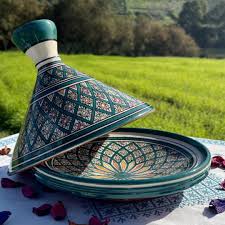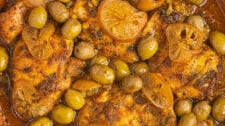The Authentic Moroccan Tagine: A Culinary Delight
When it comes to Moroccan cuisine, one dish stands out as a symbol of tradition, flavour, and community – the iconic tagine. This slow-cooked stew takes its name from the earthenware pot in which it is cooked, creating a unique blend of aromas and tastes that have delighted palates for centuries.
The Origins of the Tagine
Originating in North Africa, the tagine has deep roots in Moroccan culture. The conical shape of the cooking vessel allows steam to circulate, ensuring that ingredients are tenderised while preserving their natural flavours. Traditionally cooked over charcoal or low heat, the tagine embodies the art of patience and precision in Moroccan cooking.
Ingredients and Flavours
A true Moroccan tagine is a harmonious medley of ingredients that reflect the country’s diverse culinary influences. From succulent lamb or chicken to an abundance of spices like cumin, cinnamon, and saffron, each component plays a vital role in creating layers of taste that unfold with every bite.
The Cooking Process
To prepare an authentic Moroccan tagine is to embark on a sensory journey. The slow cooking process allows flavours to meld together, resulting in a dish that is both tender and aromatic. Whether it’s the sweetness of dried fruits or the savoury richness of olives and preserved lemons, every element contributes to a symphony of taste.
Serving and Enjoying
A steaming tagine served with fluffy couscous or crusty bread is a feast for both the eyes and palate. In Morocco, sharing a tagine is not just about food; it’s about coming together with loved ones to savour each mouthful while basking in the warmth of good company.
Bringing Morocco to Your Table
While nothing can quite replicate the experience of enjoying a tagine in the heart of Morocco, you can bring this culinary tradition into your own home. With simple recipes and an authentic tagine pot, you can recreate the magic of Moroccan cuisine and transport your taste buds to distant lands.
Embrace Tradition with Every Bite
Whether you’re a seasoned food enthusiast or new to Moroccan flavours, exploring the world of authentic tagines offers a glimpse into a culture rich in history and hospitality. Let each spoonful be a reminder that food has the power to connect us across borders and time.
Exploring Authentic Moroccan Tagine: Your Top 9 Questions Answered
- What is an authentic Moroccan tagine?
- What ingredients are typically used in a Moroccan tagine?
- How is a traditional Moroccan tagine cooked?
- What makes the cooking vessel for a tagine special?
- Are there different types of Moroccan tagines?
- Can I make a vegetarian version of a Moroccan tagine?
- What are the best spices to use in a Moroccan tagine?
- Is couscous the only side dish served with a tagine?
- How can I achieve the authentic flavour of a Moroccan tagine at home?
What is an authentic Moroccan tagine?
An authentic Moroccan tagine is not just a dish; it is a culinary tradition steeped in history and cultural significance. The term “tagine” refers to both the clay cooking vessel and the slow-cooked stew it produces. In Morocco, preparing a tagine involves layering ingredients like tender meats, vibrant vegetables, and a blend of aromatic spices in the conical pot, allowing them to simmer and meld together over low heat. The result is a fragrant and flavourful dish that embodies the essence of Moroccan cuisine, bringing people together to share in its savoury delights while honouring centuries-old cooking techniques.
What ingredients are typically used in a Moroccan tagine?
In crafting an authentic Moroccan tagine, a vibrant array of ingredients is carefully selected to create a symphony of flavours. Traditional Moroccan tagines often feature tender cuts of lamb or chicken, simmered to perfection alongside an assortment of aromatic spices such as cumin, cinnamon, and saffron. The dish is further enriched with the sweetness of dried fruits like apricots or prunes, the tanginess of preserved lemons, and the briny notes of olives. These ingredients come together in harmony within the conical confines of the tagine pot, infusing each bite with a taste that is both comforting and exotic.
How is a traditional Moroccan tagine cooked?
To cook a traditional Moroccan tagine, a method steeped in centuries-old tradition is employed. The process begins by layering the earthenware tagine pot with a combination of meat (often lamb or chicken), vegetables, and an array of aromatic spices such as cumin, cinnamon, and saffron. Slow-cooking over low heat or charcoal allows the ingredients to meld together, creating a tender and flavourful stew. The unique conical shape of the tagine pot ensures that steam circulates during cooking, infusing the dish with rich flavours and preserving the natural essence of each component. This meticulous approach to cooking captures the essence of Moroccan cuisine and results in a culinary masterpiece that delights the senses with every savoured bite.
What makes the cooking vessel for a tagine special?
The cooking vessel for a tagine holds a special place in Moroccan culinary tradition due to its unique design and functionality. The conical shape of the tagine pot allows for steam to circulate during cooking, ensuring that ingredients are tenderized evenly while retaining their natural flavours. This slow-cooking method results in dishes that are not only delicious but also infused with layers of aromatic spices and textures. The earthenware material of the tagine pot further enhances the cooking process by providing gentle and consistent heat distribution, allowing for the development of complex flavours that define authentic Moroccan cuisine.
Are there different types of Moroccan tagines?
In the realm of Moroccan cuisine, the question often arises: Are there different types of Moroccan tagines? Indeed, the world of tagines is as diverse as the landscapes of Morocco itself. From traditional lamb and prune tagines to seafood variations bursting with Mediterranean flavours, each region and family brings its own unique twist to this beloved dish. Whether savoury or sweet, spicy or mild, exploring the array of Moroccan tagine varieties is a delightful journey through a tapestry of tastes and traditions that showcase the culinary richness of this vibrant country.
Can I make a vegetarian version of a Moroccan tagine?
For those seeking a vegetarian twist on the traditional Moroccan tagine, rest assured that you can indeed create a flavourful and satisfying meat-free version of this iconic dish. By substituting meat with an array of vegetables such as carrots, potatoes, zucchini, and bell peppers, and enhancing the flavours with a blend of aromatic spices and herbs, you can craft a vegetarian tagine that is both wholesome and delicious. Embracing the essence of Moroccan cuisine while catering to vegetarian preferences, this plant-based rendition offers a delightful culinary experience that honours tradition in a new light.
What are the best spices to use in a Moroccan tagine?
When it comes to creating an authentic Moroccan tagine, choosing the right spices is essential to capturing the essence of this beloved dish. The best spices to use in a Moroccan tagine include a blend of aromatic and earthy flavours that elevate the overall taste profile. Commonly used spices such as cumin, cinnamon, paprika, ginger, and saffron add depth and complexity to the stew, creating a symphony of flavours that is both comforting and exotic. These carefully selected spices not only infuse the tagine with warmth and richness but also pay homage to Morocco’s vibrant culinary heritage.
Is couscous the only side dish served with a tagine?
In Moroccan culinary tradition, while couscous is a popular and classic side dish often served with tagine, it is not the only accompaniment that complements this iconic stew. Alongside couscous, tagines are also enjoyed with crusty bread, known as khobz, which is perfect for soaking up the rich sauces and flavours of the dish. Additionally, a variety of salads, such as Moroccan carrot salad or zaalouk (eggplant salad), may be served to provide a refreshing contrast to the hearty and aromatic tagine. The beauty of Moroccan cuisine lies in its versatility and the array of side dishes that can enhance the dining experience when savouring an authentic tagine.
How can I achieve the authentic flavour of a Moroccan tagine at home?
To achieve the authentic flavour of a Moroccan tagine at home, it’s essential to pay attention to the details that make this dish unique. Start by using a traditional tagine pot if possible, as it helps in retaining the flavours and textures of the ingredients. Select high-quality spices such as cumin, cinnamon, and saffron to create the signature taste profile of Moroccan cuisine. Additionally, consider slow-cooking your tagine to allow the ingredients to meld together and develop rich flavours. Don’t forget to include key components like dried fruits, olives, and preserved lemons for that perfect balance of sweet and savoury notes. By sourcing quality ingredients and embracing the slow cooking process, you can recreate the authentic essence of a Moroccan tagine in your own kitchen.




